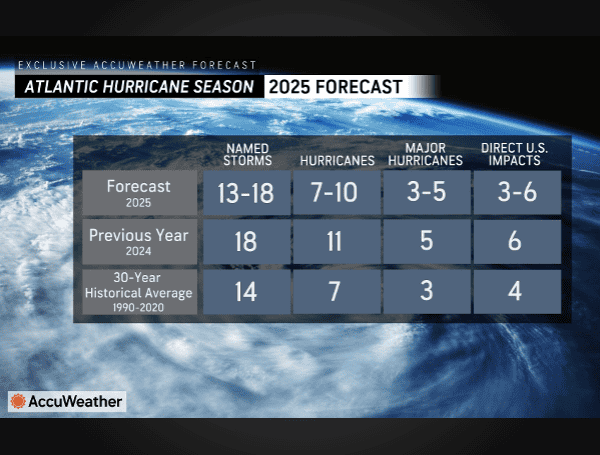As the official start of the Atlantic hurricane season approaches on June 1st, AccuWeather hurricane experts are issuing a critical warning: the potential for significant inland flooding and tornado outbreaks, similar to those seen in recent historic seasons, is again elevated for 2025. Families, businesses, and emergency officials are urged to prepare for these far-reaching impacts.
AccuWeather is forecasting 13 to 18 named storms, with seven to 10 expected to become hurricanes and three to five reaching major hurricane strength (Category 3 or higher). Experts predict three to six direct impacts to the U.S. coastline, mirroring their forecast for the devastating 2024 season.
RELATED: Colorado State University Researchers Forecast Above-Average 2025 Atlantic Hurricane Season
“We witnessed tragic examples of just how far inland the impacts from hurricanes and tropical storms can reach,” stated AccuWeather Lead Hurricane Expert Alex DaSilva. He cited Hurricane Beryl’s more than 60 tornadoes extending from Texas to upstate New York, and Hurricane Helene’s catastrophic flash flooding hundreds of miles inland in western North Carolina, as stark reminders. “I’m concerned that we could see similar situations this year, when storms form in the Gulf and then track northward into the central and eastern United States.”
A primary concern for the 2025 season is the unusually warm water across much of the Atlantic basin. While not as extreme as 2023 and 2024, ocean temperatures remain well above historical averages, providing ample fuel for developing storms. This abundance of warm water, extending deep below the surface (ocean heat content), significantly increases the risk of “rapid intensification” – a dangerous phenomenon where storms quickly gain strength just before landfall.
READ: Hybrid “Super Termites” Establish Foothold In Florida, Raising Alarm Bells For Widespread Damage
DaSilva also highlighted the potential for “homegrown development” – storms forming close to the U.S. coastline – particularly in the early and late parts of the season. This often occurs when stalled cold fronts over warm Gulf waters trigger tropical development.
Looking back, the 2024 season was one of the costliest and most devastating on record, and AccuWeather experts anticipate a similar scenario this year. The influence of Pacific Ocean phenomena like El Niño and La Niña also plays a role. While neither is expected in the season’s first half, a potential return of La Niña later in the season could lead to a particularly active end to the year, mirroring last year’s late-season surge in activity.
AccuWeather’s forecast for 2025 identifies the northern and eastern portions of the Gulf Coast, along with the Carolinas, as having a higher-than-average risk of direct impacts. Atlantic Canada and the northeastern Caribbean, including the U.S. Virgin Islands and Puerto Rico, are also urged to prepare.
By analyzing “analog years” with similar global weather patterns, AccuWeather experts gain insights into potential storm tracks and intensities. The 2017 and 2023 seasons, which saw devastating storms like Harvey, Irma, and Idalia, serve as recent matches.
READ: Get Ready: Pinellas County And St. Pete Host Free Hurricane Preparedness Expo
Beyond warm waters and analog years, other factors being closely monitored include the position and strength of the Bermuda-Azores high-pressure system, which steers storms, and conditions off the west coast of Africa, including the potential for “Atlantic Niña” which can suppress activity, or increased tropical waves that foster development.
The economic toll of extreme weather events is already significant this year, with AccuWeather estimating $353 billion to $393 billion in total damages and economic losses from events like severe central U.S. tornadoes ($9 billion to $11 billion), a rare January winter storm, and Southern California wildfires. Any major hurricane landfalls could further strain resources and worsen the ongoing insurance availability and affordability crisis in the U.S.
Please make a small donation to the Tampa Free Press to help sustain independent journalism. Your contribution enables us to continue delivering high-quality, local, and national news coverage.
Connect with us: Follow the Tampa Free Press on Facebook and Twitter for breaking news and updates.
Sign up: Subscribe to our free newsletter for a curated selection of top stories delivered straight to your inbox.

